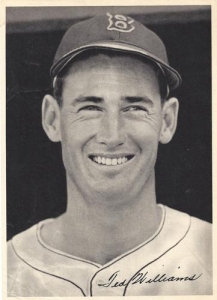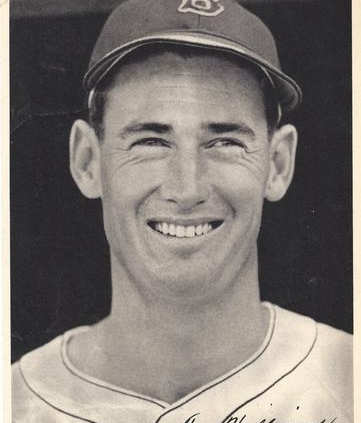May 2, 1946: Ted Williams homers in the 10th to win another game for Red Sox
 In his first at-bat after three years of military service during World War II, Ted Williams grounded out to first base unassisted on April 16.
In his first at-bat after three years of military service during World War II, Ted Williams grounded out to first base unassisted on April 16.
More befitting his legend was his second time up after returning to civilian life and the Red Sox lineup: a homer off Roger Wolff of the Washington Senators in the third inning. With President Harry Truman – Williams’s commander-in-chief until his discharge from the Marine Corps on January 28 – in attendance at Griffith Stadium on Opening Day, the Red Sox beat the Senators. Williams drove in 10 runs in April but didn’t have another home run.
On May 2 Williams hit his second home run of the year, and his first game-winning homer of the postwar years.
It was a Thursday afternoon game at Fenway Park, one that drew well, attracting 21,543.1 The reigning World Series champion Detroit Tigers were in town, managed by Steve O’Neill. They had a record of 7-6. The Red Sox were off to a tremendous start, with a record of 12-3. Virgil Trucks was O’Neill’s choice to pitch the game.
After Tex Hughson retired the first three Tigers he faced, Trucks did the same in the bottom of the first. Williams’s groundout to first base ended the inning.
Three fly balls to Dom DiMaggio in center field closed out the second inning for Detroit. The Red Sox got to Trucks in the bottom of the inning with a one-out single by first baseman Rudy York. DiMaggio walked and catcher Hal Wagner hit a three-run homer into the grandstand seats in right field. It was Wagner’s first Fenway Park home run.
Right fielder Pat Mullin bunted successfully on Hughson in the third, becoming the first Tigers baserunner. He didn’t get any farther than second base. Hughson gave up two singles in the fourth inning, but neither scored. He gave up a single in the sixth, but still had a shutout going after seven innings.
The Red Sox added a fourth run in the bottom of the sixth when Bobby Doerr doubled to left and York singled.
Boston looked comfortably in the lead, but the Tigers scored four runs in the top of the eighth and tied the game. Anse Moore pinch-hit for Trucks, leading off, with a single to left. Shortstop Eddie Lake walked. Barney McCosky, the center fielder, grounded into a force play, short to second. Left fielder Dick Wakefield singled, scoring Moore.
First baseman Hank Greenberg – on his way to leading the AL in home runs and RBI in 1946 – popped up to short. Two outs. The second baseman, Eddie Mayo, singled to right field and scored McCosky, cutting Boston’s lead to 4-2.
Pinky Higgins, the Tigers’ third baseman,2 singled to center and drove in Wakefield. Due to an uncharacteristic error by DiMaggio, the Tigers wound up with runners on second and third, so Hughson intentionally walked Mullin. Roy Cullenbine pinch-hit for catcher Bob Swift, and Hughson walked him, too, producing the tying run.
Manager Joe Cronin brought in a reliever, Clem Dreisewerd. O’Neill had a pinch-hitter – Jimmy Outlaw – pinch-hit for the pinch-hitter Moore. Dreisewerd got Outlaw to foul out to first base, ending the inning.
With the game tied, Tommy Bridges was the new pitcher for the Tigers in the bottom of the eighth.3 He retired the Red Sox in order.
In the ninth inning, both pitchers – Dreisewerd and Bridges – retired the three batters they faced. The game went into extra innings.
Dreisewerd secured outs from the first two batters in the top of the 10th, but then gave up back-to-back singles to Higgins and Mullin before getting Birdie Tebbetts (who had been Swift’s replacement behind the plate) to ground to Eddie Pellagrini at third base for a force out at second.
When the Red Sox came to bat in the bottom of the 10th, the first batter up was Ted Williams.4 He was 0-for-4 in the game and had appeared “listless and lacking his usual verve as a result of a heavy cold,” according to the Boston Globe.5
Bridges’ first pitch was a high and inside curveball which Williams fouled off. The second was a high slider and he missed it by inches. Burt Whitman wrote of Williams, who was likely angry at himself, “His head went up very soon after his swing.”
Bridges then threw a low one – another slider. “Where earlier swings had looked comparatively lazy and innocent, this one by Ted was his best cut. The ball went on a line, drilling right across the northwest wind and landed in the Tiger bullpen in far right-center.”6 The Red Sox had pulled out a 5-4 win.
Bridges lamented, saying the pitch had been “a slider which broke below his knees. I don’t know where you’ve got to throw the ball to keep that guy from liftin’ it out of the park. I certainly didn’t give him any strike.”7
Ted could return home and nurse his cold. Whitman wrote, “That clutch homer was the best self-administered cold medicine that Williams could have.”8
Bridges lost the game, of course, the last loss of his career. He won his final game, three days later in Philadelphia against the Athletics.
The win was the Red Sox’ seventh in a row. They won their next eight games, too.
Ted Williams hit homers on May 3 and May 4, too. He was voted American League MVP, finishing the 1946 season with 38 home runs and 123 RBIs. He hit .342 and had an on-base percentage of .497, leading all of baseball. His 142 runs scored and 156 bases on balls also led both leagues.
The Red Sox won the American League pennant in 1946, with 104 wins (104-50), finishing a full 12 games ahead of the Detroit Tigers. Finishing so easily ahead of the pack, they may have lost their competitive edge as they waited for the National league pennant to be resolved. Though they took the 1946 World Series to seven games, they succumbed to the St. Louis Cardinals.
Sources
In addition to the sources cited in the Notes, the author consulted Baseball-Reference.com and Retrosheet.org.
https://www.baseball-reference.com/boxes/BOS/BOS194605020.shtml
https://www.retrosheet.org/boxesetc/1946/B05020BOS1946.htm
Notes
1 Fenway Park had no lights for night games until 1947.
2 Seventeen days later, on May 19, the Tigers sold Higgins’s contract to the Red Sox. Released after the season, he managed in the Red Sox farm system and eventually the Red Sox themselves. He also spent time as the club’s general manager.
3 Bridges, a right-hander, had been given the politically complicated name Thomas Jefferson Davis Bridges. He was an established veteran who had been pitching in the big leagues since 1930, a career-long Tiger. He had a record of 194-138.
4 Burt Whitman, “Williams’ Homer in 10th Wins 5-4,” Boston Herald, May 3, 1946: 1, 30.
5 Melville Webb, “Williams’ Homer in 10th Inning Wins for Sox, 5-4,” Boston Globe, May 3, 1946: 1, 16.
6 Whitman.
7 Arthur Sampson, “Routed Tigers Sing Praises of Red Sox,” Boston Herald, May 3, 1946: 31.
8 Whitman.
Additional Stats
Boston Red Sox 5
Detroit Tigers 4
10 innings
Fenway Park
Boston, MA
Box Score + PBP:
Corrections? Additions?
If you can help us improve this game story, contact us.


